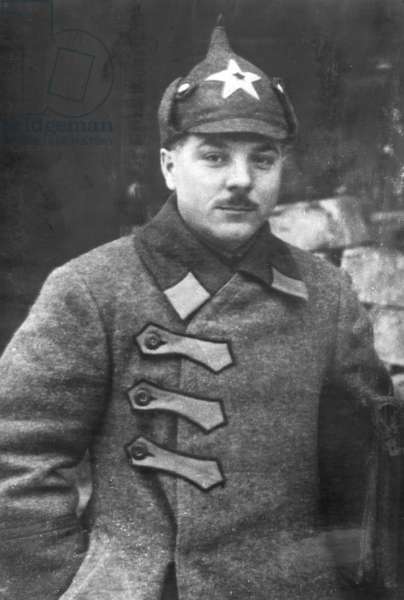Can i read about this part somewhere because google brought up Quora answers which were saying SPD good and KPD evil.
I assembled this from about 9 different books for a reddit argument a few weeks ago, if you want a timeline of SPD vs KPD
1918 - the SPD led government brutally cracks down on the German left after the November Revolution in Russia, leading to a series of bloody battles and massacres that were referred to as being “a civil war”
1918 - in order to stop the left from attaining any power, they appoint right wing military officials to as many beuracratic posts as possible, judges, local councils, clerks, etc. This is the exact machinery that enabled the nazis to take over, straight up laying the groundwork for their rise. They are warned about this by the left. The SPD ignores this.
1920 - The Kapp Putsch. A right wing coup, complete with Swastikas, is attempted by a group of far right military officers who have outsize power thanks to SPD policies. The SPD is unwilling to defend the government and nation and retreats. The government claimed they had lost control of the army - this wasn’t true, they actually had the majority of the army on their side. They literally retreated from Berlin without attempting a fight, after meeting with several of the right wing officers involved. The KPD responded by organising the largest strike in German history, 12 million workers bring the country to a stand still and defeat the coup in days. The SPD government condemns the KPD for this, refusing to ban the nazi party despite a huge push from the other parties to do so.
1928 - the nazis begin to condemn Jews and Marxists openly, blaming both for the state of the German economy. The SPD refuse to condemn this, actually adopting some of their anti Marxist rhetoric against the KPD.
1928 - The KPD suggest a left wing alliance to defeat fascism. The spd reject it.
1929 - the authoritarian Heinrich Brunig, a right wing leader who the SPD supported as a “lesser evil” to Hitler over the KPD suggested left wing alliance, whom they are in a coalition government with, ravages the welfare state, raises taxes, suppresses unions and forces down wages. The SPD support and vote for all of these measures. This plunges millions into poverty and suffering and erodes much of their support overnight
1929 - the KPD warns that the SPD support of the Brunig policies is bleeding their support straight to the nazi party. The SPD ignores them.
1929 - the KPD (and several smaller parties, unions, anarchists and other groups who are on board this time) propose a left wing alliance to the SPD, for the second time. they reject it.
1930 - Thalmann publicly offers a left wing alliance, stating he will “forget about Rosa”, recognising the threat of Fascism. The SPD do not respond, and reject this offer.
1930 - Thalmann suggests the SPD do something to stop the rampant disease and poverty caused by the policies they had supported and helped Brunig Implement. They reject both this and the suggestion that their “campaign on the left, govern on the right” strategy has cost them crucial support to the nazis.
1930 - The SPD state that there is “no difference between Thalmann and Hitler, between communists and fascists” for the first time. They would later campaign on this.
1931 - the SPD finally form a leftist alliance, the so called Iron Front, made up of themselves, a minority of trade unions whom still supported them and athletic clubs. The KPD instructs its members to join. The SPD states openly that they do not want the support of the KPD and the left and do whatever they can to cut them out. Despite this, the KPD organises their members to cut any KPD alliance out of their trade unions so they can join, bringing the number of members to roughly 3-4 million. The SPD continue to suppress the left within the group, making both it and its paramilitary wing designed to fight the brownshirts incredibly ineffective.
1931 - the KPD warns that the SPDs obsession with parliamentary process and compromise would not defeat the nazi party as they had no respect for either and would do whatever it took to attain power. The SPD calls this fear mongering and states its unfounded.
1931 - Antifascischistsche Aktion or antifa is formed by the KPD to bring some kind of order to the left who had been fighting nazis on the streets since the 1920s. The SPD refuses to support them and begins blaming them for violence caused by the brownshirts, as does Bruning and the nazi party.
1932 - the German socialist party, the SAP, make a public plea for left unity - “The divisions in the labour movement run deep, but not as deep as the desire, in this hour of imminent danger, to temporarily overcome these divisions in order to prevent the labour movement, regardless of our strategic and tactical differences, from being defeated entirely. There is unity in the desire to push back fascism, to push back wage decreases, to defend the welfare state and to prevent war. Therefore we suggest to you [leadership of KPD, SPD and trade unions] to take these four points as the basis for a common struggle involving all of the organisations of the working class”. - the KPD align with them. The SPD refuse.
1932 - the SPD refuse the offer of a possible alliance with the KPD/SAP coalition for the upcoming election, under estimating their massive loss of support. This proves to be a fatal mistake, as the KPD and SPD together receive more than a million votes more than the nazi party. Thanks to the SPDs disastrous support of Bruning’s policies, they lose nearly 8 million votes from the previous election.. Nearly all of which now go to the nazi party.
1933 - the SPD agree with Hitler’s policy to outlaw the KPD and refuse to condemn his decision to close the KPD newspaper.
1933 onwards - 1 in 3 KPD members are murdered. The rest are either sent to camps or escape. The SPD are eventually outlawed as well but do not suffer the same punishment or death toll. Many former SPD members end up high ranking nazis.
One group enabled Hitler and it wasn’t the KPD or Thalmann.
Thank you
Obviously it's missing Rosa, Karl and the Spartacists because I'd already addressed those earlier in the comment I put that together for and I missed out both the actions of Zentrum (who were just as bad as the SPD) and the signing of the enabling act that both the SPD and Zentrum ruled out not signing when asked and just handed total power to Hitler and the Nazi party, because I added that in later. But aside from those omissions it's a pretty good timeline of what happened.
I'll redraft it slightly to add in more specific dates and some of things that are missing, as well as the source list (which I kept in case I was called on anything) and I think I'll post it there in a few days when I've had time to do so. That's a good idea though, it's such a common argument libs throw out there (especially so at the moment for whatever reason) it might be good to keep it somewhere for reference.
you could maybe add some of the stuff before 1918 that led to the fallout between SPD and USPD, particularly the SPD's support for WW1. them being an imperialist, national-chauvinist party played a huge role in setting up the events you're describing.
That was actually one of the things I thought I needed to add, there's a view things before 1918 that I think I need to add because they lay the groundwork for all that follows.
It leaves out some important events:
1920 - During the Kapp-Putsch fighting breaks out in the French-Occupied areas of Western Germany (Ruhr) between the spontaneously-organized Red Ruhr Army [consisting of members of the USPD ("centrist marxist" party, preferring reformism but not rejecting violence) KPD, SPD, KAPD (Leftcoms) and a large presence of the anarcho-communist FAUD] and the Freikorps. The uprising is put down by the central SPD-led government after it refused the Red Ruhr Army's request to create a socialist government there.
1923 - Hyperinflation breaks out in Weimar Germany and the Landtag Elections in Saxony and Thüringen lead to the local SPD branches allying with the KPD in both states in a coalition government. The SPD-led government disapproved of that and sent in the army to dissolve the state governments of both states. This leads to the Hamburg Uprising led by the KPD's Ernst Thälmann, which however is quickly defeated by the Army as no external help from other parts of Germany came.
1925 - Paul von Hindenburg gets elected President with support from the monarchist DNVP, libertarian DVP and reactionary regionalist BVP with a narrow victory over the conservative Zentrum (backed by the SPD) candidate Wilhelm Marx. Fast forward to 1932 and the centrists didn't bother fielding their own candidate, because obviously the man who literally did a military right wing coup d'Etat in 1917 to keep the German Empire pro-War was so clearly the lesser evil to Hitler outright winning and wouldn't legitimize a NSDAP electoral victory giving it more legitimacy than if Hitler had just seized power in a coup following a presidential election victory.
1932 - Massive strike in Berlin's public transportation company BVG, enthusiastically supported by the KPD and opportunistically supported by the local Nazi Party. This leads the SPD to break out the Horseshoe and do the usual "communism = nazism". This leads to massive gains for the KPD as both the SPD and especially the NSDAP lose a shitton of votes. The Nazi Party loses over 4% of the vote in the November election and the KPD climbs to a record high 17% of the vote.
1932 - von Hindenburg appoints right wing strongmen as he pleases and transforms lesser-evily the Weimar Republic into a de facto reactionary military dictatorship. Von Schleicher, General of the Reichswehr and current Chancellor even attempts to form a unity government with the left wing (!) of the NSDAP, bypassing Hitler and contacting Gregor Strasser, but it failed. Then von Schleicher supported Hitler opportunistically, hoping for a ministerial posting. He got purged in 1934.
June 1932 - The KPD proposes the creation of the "Antifascist Action" alliance with the SPD. It gets ignored despite mounting violence against leftists.
20th February 1933 - A group of the leading Bourgeoise in Germany meet with NSDAP leaders in secret and donate 3.000.000 RM to the NSDAP's electoral campaign
Oh no doubt, it was something I put together in an hour that was a complement to other things I said. The reason I didn't bring up the Ruhr specifically was the person I was responding to had brought that up - without mentioning the Kapp Putsch, for some reason that's definitely not obvious - as an example of leftist violence. Definitely needs improvement, I'm currently working on a better version.
This is a decent timeline, but there's one point that can be improved: in 1920, I think it was the USPD (the party of independents that split from the SPD in the 1910's once it became clear they had become compromised to the German bourgeois) that led the charge for a general workers strike which, after fleeing Berlin, Ebert and Scheidemann of the SPD rallied behind.
The KPD was at first quite hesitant to support the strike, since the strike demands would result in the reinstatement of the old Ebert SPD-led government. Levi, who was ostensibly the leader of the KPD (though at the time imprisoned), was of the belief that the KPD's position was a critical mistake (which it probably was, since even once the Kapp putsch was defeated, strikes persisted for awhile longer with stronger demands. If the KPD found itself as the vanguard, their list of demands which included disarming the bourgeois forces, arming revolutionaries, re-instating worker's councils, socializing many of the industries, the removal of the right wing of the SPD, and more, would have done some serious work towards creating a Socialist Germany).
This is all from Pierre Broue's German Revolution, 1917-1923, by the way. It's pretty exhaustive, is sympathetic to the KPD, but shows in many places where the KPD and the Spartacus party were lacking in vision or cohesion, and how the SPD (which was after 1918 certainly a centrist part) had a strong grip on a lot of the union leadership at the time, which in many cases acted together as a counter-revolutionary force. If anyone wants a link to the pdf just let me know.
Thank you, the person I was arguing with (which I'm pretty sure is the alt of a mod because I was abruptly warned by them after I posted this) has demanded my discord username for the past few weeks because they want to "debate me voice to voice" and is now sending me messages calling me a coward for ignoring them.
I am in awe at the quality of this post. Truly amazing work. Thank you!
Edit: found the german source I was looking for. I really hope someone translates this into english http://antifaeu.blogsport.de/images/80J_AA_web.pdf
I had to crudely translate all this in the past
The KPD reacted to these developments with the call for "United Front Action", which shortly afterwards in "Antifascist Action" was renamed. The reason was a brawl between members of the Nazi party and Communist MPs in the Prussian state parliament on May 25, 1932, which resulted in eight seriously injured people. The next day the headline in the Red Flag was: “Cowardly attack by the Nazis in the state parliament on communists - anti-fascist action - appeal by the central committee of the KPD to the German working class”. Over the next few weeks took place all over the empire District congresses of the anti-fascist action take place. This coincided with developments at the grassroots level. It was the Nazis which KPD, SPD and other leftists, so to speak beat in a front. On the street, people often stood together without paying attention to their party affiliation, simply because of that Situation. KPD members, most of whom were unemployed, organized house protection squadrons27 anti-fascist self-help, in which of course all concerned took part. So the practice was often different than the party line. However, the assumption goes that the pressure of the grassroots would have prevailed in the KPD - which then with to have contributed to the establishment of the anti-fascist action - past reality. In 1932 the KPD was through and through the Stalinist party, grassroots influence over the party leadership was ruled out. The genesis Rather, the anti-fascist action took place in the well-known content / strategic concept of the “united front policy” according to the Comintern's specifications and did not mark a break with the anti-social-democratic line. Obviously Was the anti-fascist action a communist counter-foundation to the Iron Front?
This can easily be proven with the proclamations and papers of the anti-fascist action. It is worth mentioning here the brochure Ernst Thalmann's answer to 21 questions from SPD workers, which was distributed in a mass edition by the KPD and represents something like a basic paper for the anti-fascist action should. According to legend, 20 Social Democrats from different districts met with Ernst Thälmann on July 8, 1932 in the Karl-Liebknecht-Haus in Berlin. A little later, the question and answer game appeared in the named one Notebook. In terms of content, the publication consists of a series of phrases. One searches in vain for the concrete answer to just one single question.
As an example, Thälmann's reply to whether the anti-fascist Action about a "communist party shop" is reproduced: “It is a non-partisan collecting tank for all workers who are willing to fight ruthlessly against fascism. It is not an organization, but a mass movement. She is the stream into which all the fighting forces flow which is really the struggle, the mass attack against the current government, which is the immediate erection of the fascist To operate a dictatorship, to want to implement it. The leadership of the special unity committees in the factories, in the streets the stamp points etc., must of course be in the hands of the workers themselves willing to fight. ”28
Finally, on July 10, 1932, the campaign led to a "Reich Unity Congress" in Berlin Philharmonic. According to KPD information, 1550 delegates were present, 379 of them Communists and 132 SPD members (including members of the Reichsbanner) and 954 non-party members. To what extent these numbers, especially with regard to the SPD members who corresponded to reality are difficult to verify in detail. Like everything else with that Antifascist action has to be done because there were no membership cards. The anti-fascist action emerged from the practical participation. The congress decided on a »vow of anti-fascist action« and a manifesto.
This manifesto has the same diction as the Thälmann brochure. On the meaning of the anti-fascist action can be read: "The anti-fascist action does not want to tolerate the establishment of a fascist dictatorship over Germany, that the class organizations of the proletariat have been smashed and forbidden, that all rights of the working class have been trampled upon, that social security and all the gains of the labor movement will be eradicated. The anti-fascist action organizes in the broadest united front the closed red mass self-protection of workers, unemployed and working people in whole Germany. The anti-fascist action wants the mass struggle of all class-conscious workers, all anti-fascists Freedom fighters for the crushing defeat of Hitler's fascism, for the recapture of millions of working people betrayed by the National Socialists. ”29
The "Red Mass Self-Protection" mentioned here had been proclaimed analogous to the hammer shanks of the Iron Front. With the anti-fascist action, the communists wanted both the party base of the SPD and the Include the NSDAP in their policy against the system. In this context, the joint BVG strike from RGO and NSBO (National Socialist Company Cell Organization) on display in November 1932. It came then to demonstrative appearances and speeches by members of the SPD and the Reichsbanner, now and then SA men on the podium and declared their cooperation. The emblem with the double flags, the KPD and SPD (of course only meant the SPD base, not the party as such) in a lifebuoy with the inscription "Antifascist Action" symbolized, From then on it appeared in virtually all KPD publications and demonstrations. The design came from the graphic artists Max Keilson and Max Gebhart, members of the Association of Revolutionary Visual Artists in Germany (BRBKD) 30 were. From this point on, the KPD's propaganda was in full swing. The party tried to present a successful initiative with posters, newspapers and special supplements. Indeed it succeeded, especially SPD members with the Address anti-fascist action. To this extent the policy of the KPD was successful, which primarily continues directed against social democracy. The SPD, on the other hand, made no distinction between Nazis and Communists, which meant that every SPD member who wanted to take part in the anti-fascist action had to stand against his own party.
Where did the idea of the KPD refusing to cooperate come from? Was there some event that's taken out of context, or was it totally made up?
I always go with Olgin's chapter on the SPD in his work on Trotsky https://www.marxists.org/archive/olgin/1935/trotskyism/12.htm
This is one of the sources I used, its a really good overview. I kind of cannibalised the basic structure he lays out for the SDP refusing any kind of alliance against fascism and built the timeline I wrote above around that.
Pretty sure if the KPD ever wanted to do some kind of anti-fascist united front with the centrists, it wouldn't have been just vetoed by the Zentrum, DtSP, DVP, etc. but even the majority of the SPD would flat out reject them
There's been a huge uptick of this kind of rhetoric in the past month. I know this is an old tweet but did someone make a video on this or something. It's insane. 5 times I've found myself in arguments with libs about this in three weeks.
it's a bit tricky, but you can work around repeating the accusations while debunking this stuff
Whether that effect happens has gotta depend on certain circumstances- it literally can't be just "when someone says something you are mentally incapable of believing it"
Yeah agreed, "Admit you were a fraud all along you stupid piece of shit" is not high on the list of rhetorical tools
Is she calling the SPD centrists? How far to the right does that put an average Democrat?








